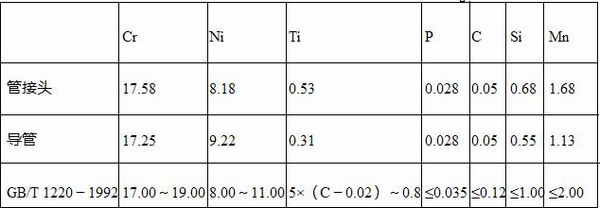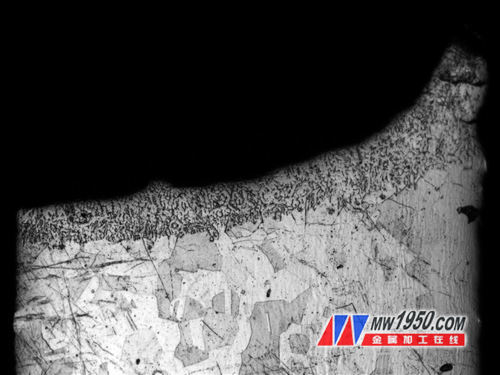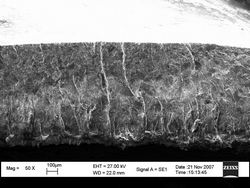1. Overview
During the charging and vibration testing of a product, a 1Cr18Ni9Ti pipe joint was found to leak from its fillet weld. After repair welding, the pressure test continued without any leakage at the repaired area. However, a new leak occurred at another pipe joint and along the fillet weld of pipe A. The pipe joint in the combined conduit is made of 1Cr18Ni9Ti hexagonal steel, while the pipe itself is a 1Cr18Ni9Ti cold-drawn tube. The welding process followed these steps: matching the pipe and joint, pickling, welding, performing strength and airtight tests, passivation, cleaning, painting, and final inspection.2. Failure Analysis
(1) Macroscopic Observation: Figure 1 shows the macroscopic view of the pipe joint fillet weld, where cracks were observed near the weld area. The crack is located within the black-marked region, aligning with the weld line as indicated by the arrow. Visual inspection revealed no visible macroscopic defects at the cracked corner welds.

Figure 1: Macro photo of pipe joint fillet weld
(2) Chemical Composition Analysis: Samples from both a 22 mm tube and a 6 mm pipe joint were analyzed. The chemical composition results, presented in Table 1, showed that all elements met the requirements of GB/T 1220-1992 for stainless steel materials.
Table 1: Chemical composition (mass fraction) of pipe joints and conduits (%)

(3) Hardness Test: A sample was cut perpendicular to the 22 mm duct axis, and micro-hardness tests were conducted on the fillet weld and base metal. The results, shown in Table 2, indicate that the hardness of the weld zone is significantly lower than that of the base metal.
Table 2: Hardness test results of welds and base metals (HV)

(4) Metallographic Observation: A metallographic sample was prepared perpendicular to the crack surface. In the weld area near the 22 mm duct, a clear weld line was observed, with the fusion line coinciding with the solder fillet. The structure transitioned continuously from the weld to the heat-affected zone and then to the base metal, with no welding defects like porosity or slag inclusions found. On the left side of the weld line, the microstructure showed dendritic ferrite in an austenite matrix, while the right side showed austenite grains.

Figure 2: Weld area close to 22mm duct

Figure 3: Crack propagation path and tissue near the crack

Figure 4: Fatigue strips in the fracture
Observations showed that the crack originated within the weld area, approximately 130–160 μm from the fusion line, and ran parallel to it. The crack boundary aligned with the solder fillet, and the surrounding microstructure consisted of dendritic ferrite in an austenite matrix.
(5) Fracture Observation: By separating the weld along the crack, the fracture surface was examined. A distinct fatigue band was observed, confirming the crack was due to fatigue. Some steps with varying heights were also noted on the fracture surface. Radial ridge lines extended from the outer surface toward the inner side, indicating multiple fatigue sources near the outer surface of the duct. These sources were identified as quasi-cleavage fracture surfaces, with no defects such as voids or inclusions present.


Figure 5: Topography of the fracture
3. Discussion
Based on visual and fluorescent testing, the crack originated at the fillet weld between the pipe and the joint, aligning with the weld bead near the 22 mm pipe. The fracture morphology revealed significant fatigue bands, with strip widths around 2 μm, indicating fatigue-induced cracking. The fracture surface showed large undulations, with the end region of the fatigue crack appearing fan-shaped. The center of the fan pointed toward the outer surface of the fracture, and the fatigue crack source was near the outer surface of the weld. Multiple fatigue sources were observed, suggesting a multi-source fatigue failure. No material or weld defects were found near the crack source, confirming the crack was a normal fatigue fracture caused by stress exceeding the fatigue limit during vibration.

Figure 6: Fatigue source at the outer surface of the weld
The chemical composition of the fittings met the required standards, and the hardness ranged from 202 to 216 HV. However, the weld zone exhibited lower hardness, making it more prone to yielding under the same stress level. Microstructural analysis confirmed the absence of pores or inclusions in the weld, indicating a normal weld structure. Cracks formed at the fillet weld, extending along the weld, approximately 130–160 μm from the fusion line. Fatigue cracks developed at the weakest point of the weld, where the cross-section was smallest and hardness was lowest. As vibration continued, these cracks expanded until they reached the inner surface, causing leakage.
4. Conclusion
(1) Cracks were caused by fatigue cracking. (2) Fatigue cracks originated from the outer surface weld legs and had multiple sources. (3) Fatigue cracking occurred at the weakest part of the weld, near the weld line, and was a typical fatigue fracture. (4) Stress concentration at the weld feet during vibration led to fatigue cracking.
Sliding radial bearings,Roller radial bearings ,Ball radial bearings
Yuyao Shuguang stainless steel bearing Co., LTD , https://www.shuguangbearing.com